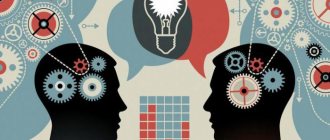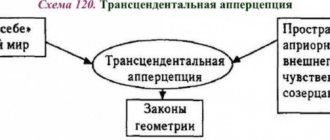It is difficult to imagine the existence of people without interpersonal communication. Human life is made up of situations that involve other people, and the quality of our interactions with others affects the quality of our lives.
We can confidently say that interpersonal relationships are a science that reveals in detail the world of communication between people and its influence on us. Each person has his own schema for perceiving other people, such schemas are called interpersonal perceptual effects.
In this article:
How we perceive another person The effects of impressions and their influence on communication What is your pattern of cognition of another person
Mechanisms and effects of interpersonal perception
— Where does communication begin? Of course, “at first sight,” that is, communication begins with observing the interlocutor, his appearance, voice, and manner of behavior. Psychologists say in this regard that one person perceives another. Effective communication is impossible without correct perception, assessment and mutual understanding of partners. Now we will talk about what influences our perception of other people, what are the mechanisms of interpersonal perception. Let us analyze how perception effects that arise during communication can cause errors in assessing the person with whom we are communicating.
So, people’s cognition and understanding of others and themselves occurs in accordance with the psychological mechanisms of perception. Let's consider these mechanisms:
1) Identification
is a way of understanding another person through conscious or unconscious likening oneself to another. Identification is the process of almost complete identification of a person with an interlocutor during communication.
(This helps, figuratively speaking, to “get into the shoes” of another person, to feel, understand and experience everything that he feels, understands and experiences).
Examples.
A perception mechanism close to identification is empathy.
This is not a rational understanding of the problems of another person, but the ability to have deep emotional contact and empathy for another person, helping to better understand him and respond to his needs and problems. This perception mechanism is most desirable both in communication with colleagues and in communication with patients.
2) Reflection
- this is the process of logical analysis of the problems, actions and states of the interlocutor, leading to certain generalizations and conclusions about the person. Reflection also means a person’s ability to understand how he is perceived by his communication partner. Examples.
3) Stereotyping
is a way of understanding another person by classifying forms of behavior and interpreting their causes by relating them to already known social patterns. A stereotype is a formed image of a person that we use as a stamp. A stereotype is formed on the basis of a generalization of personal experience and information from books and films. At the same time, knowledge can be not only questionable, but also completely erroneous. Examples.
Meanwhile, the stereotypes formed on the basis of this knowledge are very persistent and popular. So, without hesitation, we talk about the precision of a mathematician, the discipline of a military man. That all businessmen are speculators, and all officials are bureaucrats.
Stereotypical perception is enhanced by good or bad health and mood. So, when you feel unwell, people and events are perceived in a more negative light.
By studying the processes of perception, psychologists have identified typical distortions of ideas about another person. They are called effects.
"Halo effect"
" This effect is manifested in the fact that at the beginning of acquaintance, the general impression of a person leads to an overestimation of unknown qualities: the general favorable impression left by a person leads the subject to positive assessments of those qualities that are not given in perception and therefore not observable. At the same time, a general unfavorable impression gives rise to correspondingly negative evaluations. Thus, the halo prevents one from seeing the actual features and manifestations of the object of perception.
"Projection Effect".
The essence of this effect is manifested in the fact that we tend to attribute our advantages to a pleasant interlocutor, and disadvantages to an unpleasant one.
The effect of “primacy and novelty”
(First and Second Order Effect) This effect appears when we are faced with conflicting information about a person. If we are dealing with a stranger, then we tend to trust more the information that came first. When communicating with a person we know well, we tend to give preference to the information that was received most recently.
— Of course, no one can completely avoid mistakes, but we can understand the peculiarities of perception and, knowing about possible distortions, learn to correct our mistakes.
If you are the author of this text and believe that your copyright is being violated or do not want the text to be published on the ForPsy.ru website, send a link to the article and a removal request:
Technology of perception development
Perception creates a picture of reality based on the activity of an entire system of brain analyzers. The process of perception is physiological. Soviet psychologists L. Vygotsky and A. Zaporozhets talk about motor skills and vision as important factors in the development of perception. Eye movement plays an important role in the development of visual perception.
A fixed eye cannot perceive objects as a whole. With kinesthetic perception, connections arise, including space and time. With this type of perception, the reverse process occurs, providing control over the hands, which perform a variety of actions: from micro-movements to modeling.
For a person, the first significant changes in the perception of the world and perceptual actions occur in the first years of life. One of the decisive roles is played by sensory perception; from childhood, the accumulation of ideas about the color palette, shape, properties and size of surrounding objects begins.
Development technologies can be very diverse. Educational games that bring actions to automaticity, for example, comparing quantities through game manipulations, in which new information is learned. Gradually, the comparison of figures turns into visual perception, and the movements of the hands become more complex, and the sense of touch is involved.
Active search actions and the formation of connections between vision, hearing and touch make it possible to perceive complex signals, distinguish them, build connections, recognize and interpret.
Thus, not only is perceptual development important in its own right, but it is also an example of behavioral and neural plasticity—powerful mechanisms that can support developmental changes in many areas, beginning in early life.
Visual illusions at Palazzo Spada in Rome
At the Palazzo Spada in Rome, the architect Francesco Borromini created an interesting optical illusion - an altered perspective, where descending rows of columns and a rising floor create the impression of a gallery 37 meters long (in fact, its length is only 8 meters). The man who appears at the end of the corridor appears to be a giant, and the sculptures, 60 cm in height, appear to be the size of a man. A mathematician helped the great architect in creating this illusion.
A striking impression is created thanks to the sloping floor, the gradual decrease in the height of the columns and the corridor itself. Look at the schematic representation of the corridor from the side and from above.
Impossible figures
Impossible figures are those illusions of optical illusion that cannot exist in the physical world, but look quite real on paper.
Mechanisms of social perception
The tools used by social perception ensure the establishment of communication between individuals and consist of the following concepts:
- Identification;
- Empathy;
- Attraction;
- Reflection;
- Stereotyping;
- Causal attribution.
The identification method consists in the fact that the psychologist tries to put himself in the place of the interlocutor. To get to know a person, you need to understand his scale of values, norms of behavior, habits and taste preferences. According to this method of social perception, a person behaves in the way that, in his opinion, his interlocutor might behave.
Empathy is empathy for another person. Copying the emotional mood of the interlocutor. Only by finding an emotional response can you get a correct idea of what is going on in the soul of your interlocutor.
Attraction (attraction) in the concept of social perception is considered as a special form of cognition of a partner with the formation of a stable feeling for him. This understanding may take the form of friendship or love.
Reflection is awareness of oneself in the eyes of the interlocutor. When conducting a conversation, a person seems to see himself from the partner’s side. What the other person thinks about him and what qualities he gives him. Self-knowledge in the concept of social perception is impossible without openness to other people.
Causal attribution from the words “cause” - cause and “attribute” - label. A person is endowed with qualities according to his actions. Social perception determines the following types of causal attribution:
- Personal – when the reason comes from the person who committed this or that act;
- Objective – if the cause of the action was the object (subject) towards which this or that action was directed;
- Circumstantial – the conditions under which a particular act was committed.
In the process of research, according to social perception, patterns were identified that influence the formation of causal attribution. As a rule, a person attributes success only to himself, and failure to others, or to circumstances that, alas, were not in his favor.
When determining the severity of an action directed against a person, the victim ignores objective and detailed causal attribution, taking into account only the personal component. An important role in perception is played by the person’s attitude or information regarding the perceived subject
This was proven by Bodalev's experiment, which showed a photograph of the same person to two different social groups. Some said that before them was a notorious criminal, others identified him as the greatest scientist.
A social stereotype is the perception of an interlocutor based on personal life experience. If a person belongs to any social group, he is perceived as part of a certain community, with all its qualities. A clerk is perceived differently than a plumber. Social perception shares the following types of stereotypes:
- Ethnic;
- Professional;
- Gender;
- Age.
When people from different social groups communicate, contradictions may arise, which are smoothed out when solving common problems.
Magic score
The essence of the trick is as follows.
- the magician asks the spectator to guess a number from 1 to 10, but not to say it out loud. In general, from the moment the trick begins, do not say anything loudly. Everything that the magician asks to be done is done mentally by the viewer.
- After this, the wizard stipulates the conditions: he calls the numbers up to ten in order, and if this is not what the viewer wished for, then he must mentally scream with all his might: “No!” As loud as it can be. The eyes, of course, must be closed.
- When the turn comes to the hidden number, the viewer should imagine it as just a huge, large block of stone, which seems to be bursting out of the ground and towering above all living things.
- After the counting is completed, the spectator opens his eyes, and the magician calls out the number he had guessed.
The secret of the trick: despite the seeming unreality of the performance, the secret is simple.
The psychological characteristics of people make almost everyone react the same way. When numbers that are not his are being listed, some lightly, barely noticeably nod their heads. Or they simply remain completely still. However, as soon as the turn reaches the desired number, the eyelids tremble and rise slightly. It is this subtle, barely perceptible moment that the magician catches. Surprisingly, the reaction of almost all people is the same.
Types and levels of communication.
The following types of communication are distinguished:
A) Intrapersonal communication
. This is a person’s internal dialogue with himself, thinking about problems, various issues, analyzing situations, making plans, etc.
B) Interpersonal communication
. This is communication between two or more people. Includes all the variety of forms and styles of communication.
B) Social communication
. This is communication between a person and a group of people, a team, or a large audience.
— You have observed more than once that in different life situations you face different goals and your different personal qualities are revealed. Depending on the situation, you choose one or another style (level) of communication.
The following levels (styles) of communication are distinguished:
A) Primitive level
At this level of communication, the other person is assessed from the point of view of need or unnecessaryness, usefulness or uselessness. When it is “necessary” or “useful,” they come into contact with the person; when it is “unnecessary,” they do not enter into contact or rudely push him away if he interferes with the achievement of any goal. In this case, the person is actually used as a thing, since after obtaining the desired result, interest in him, as a rule, quickly disappears (when communicating with a patient, this type of communication is unacceptable).
B) Manipulative level.
This level of communication is close to primitive, since it is also aimed at obtaining some benefit from the interlocutor. At the same time, the true goal is hidden from the person in every possible way. In such communication, a wide variety of methods of psychological influence on and control of a person are actively used. For example: flattery, intimidation, showing affection, deception, “showing off”, etc.
7 pages, 3014 words
Forms of communication between people, expression of feelings and emotions, manifestation of friendship and love
... is the main determining factor in communication between people, representing a set of certain codes formed by the cultural baggage of a given level, facilitating or complicating communication, but always determining ...
This type of communication is also unacceptable during interaction with the patient.
C) Formal role level.
At this level of communication, each participant acts strictly in accordance with his social role and position. It actually does not take into account individual personal qualities, the inner world of a person, his problems, etc. n. This style of communication is permissible only in rare extreme conditions, when the patient needs to provide urgent assistance and there is no opportunity to study his personality.
D) Business (professional) level.
Business communication occurs among people, as a rule, in connection with their participation in a certain joint activity and has the goal of achieving a common result. Therefore, at this level of communication, the individual characteristics of the interlocutor’s personality are taken into account, but the interests of the matter prevail, and even possible differences in views or opinions, as a rule, fade into the background. This style of communication occurs quite often between people.
D) Friendly level.
This level of communication is characterized by maximum openness of people to each other, sincerity, and trust; emotional experience for another person, sympathy for his problems, as well as readiness for mutual support and mutual assistance. This level of communication is acceptable when communicating with colleagues and close friends.
E) Communication at the level of “mask contact”.
This is a level of formal communication in which the interlocutors do not have the need and desire for a deep understanding of the other person, when a set of standard socio-psychological “masks” is used: politeness, compassion, respect, rigor, etc. In this case, the “mask” means a certain set of gestures, facial expressions, words, intonations. All this allows a person, firstly, to hide his true attitude towards his interlocutor; secondly, to protect yourself from the unwanted intrusion of others into your inner world, and thirdly, if necessary, to “smooth out rough edges” in relationships between people.
7 pages, 3353 words
Higir. How to find out secret thoughts by gestures
... the situation would be more suitable for you with gestures of open hands and unbuttoned clothes. Gestures of preening and courtship Research conducted ... in courtship, being the main “litmus test”. Communication with a sexually attractive partner makes the pupils involuntarily... in the functioning of the entire management apparatus, the cultural level of the manager, his style of activity, which should...
G) Secular level
This level is characterized by superficiality and pointlessness. People exchange phrases, words, signs of attention in strict accordance with generally accepted rules in a given society
What is your pattern of knowing another person?
Now, knowing about the effects of perception, you can safely control and track them, this will help you more accurately form an image about a new person and build relationships that are safe, first of all, for yourself.
You can test yourself through personal introspection and constant training. Wherever you are, you can do this, for example, in a store, when you look at the seller and observe his behavior and manner of speaking, public transport is generally full of strangers, you should be more observant and, based on situations, ask yourself questions:
- “Fatigue on a woman’s face, what is she talking about?”
- "Where can he go?"
- “For what reason is a person dressed so smartly?”
- “Why does he brazenly and openly look at everyone?” etc.
Of course, the answers are speculative, but such training will allow you to develop and expand your own capabilities in knowing other people. You will develop an automatic assessment of the maximum number of indicators and signals that will be truthful.
By getting to know yourself and knowing your own projections through which you look at the people around you, it will become simple and easy for you to see their true traits and characteristics, and not use substitute concepts.
You should not be afraid to be a true observer, you need to ask yourself questions and stop your imagination in time. Not all people with a pleasant appearance and a calm voice are kind, and not all thin people are angry and nervous. It’s worth learning this yourself and teaching your children, because it will help you be attentive and protected.
Audience effect
A person does the same things differently when alone and in the presence of other people. Moreover, observers can influence both positively and negatively. For example, a person will perform better at work that is familiar to him and perform worse at new assignments when someone else is near him.
Psychologist Robert Zajonc believed that observers cause arousal because their reaction to a person’s actions is unpredictable. When a person does what he knows and knows, it is easier for him to cope with psychological stress and fear of evaluation than if he takes on a completely new unfamiliar task.
Card from a bag
A very interesting trick, based both on mentalism and on careful preparation of the props in advance. The effect of the focus is as follows.
- Having beautifully shuffled the deck of cards, the magician lays it out like a fan in front of the viewer, inviting him to choose any one and pick it up. After that, he puts all the remaining cards in a box.
- Then he takes out two more cards from the deck and asks the spectator to connect his own with them.
- Shuffles and hands it to the person, asking him to tear all three into four parts.
- He puts the scraps into a large paper bag and gives them back to the viewer for mixing.
- Then the magician takes the bag in his hands and begins to remove pieces from it one by one.
- After their number reaches four, the wizard turns them face up, connects them and receives the spectator's card.
The secret of the trick: the whole point is in the pre-prepared top cards of the deck.
The first two of them need to be pricked with a needle at the corners so that you can feel the tubercles with your fingers. Then a false shuffle so as not to lose these two cards, and it is them that the magician takes to the spectator’s card.
As a result, a person tears three cards into four parts, two of which are pre-marked with an invisible mark. Now the wizard will remove from the bag only those pieces that have no tubercles at the corners. This is how the desired card will be assembled.
Recent Entries
- 1. Features of psychology as a science, its tasks
- Types of student activities
- General concept of intelligence
- General characteristics of a person’s motivational sphere
- Diagnosis of selectivity of attention
- Conflicts as the struggle of animals for vital resources
- Subject and method of pedagogical conflictology
- Dr. Freud and his teachings
- Social ecology is a science and educational subject in the professional training of social work specialists
- Analysis of case studies of therapy
- Development of Russian psychology in the 19th century
- Basic principles and methods of managerial psychology 2
- Coping with difficult life situations
- Guidelines for conducting practical classes in sections 1−3 of the discipline “Psychology”
- in the course "Psychology" 2
Lecture No. 1. Psychology of communication
Man is unthinkable without people.
Goethe
Goal: To study the topic “Communication”. Expand the meaning of the concept of “communication”; consider types and levels of communication. Introduce students to various means of communication, reveal techniques of non-verbal communication
Pay special attention to the mechanisms of interpersonal perception and understanding of people in the process of communication. Give an idea of the main phenomena of interpersonal communication; analyze the reasons leading to distortion of information in the process of people’s perception of each other
Develop skills in interpreting nonverbal means in communication. Develop the ability to better perceive and understand other people in the process of communication.
Plan:
1. The concept of communication.
2. Types and levels of communication.
3. Means of communication.
4. Mechanisms and effects of interpersonal perception.
The essence of interpersonal perception
Interpersonal perception is a side of communication that includes the exchange of information and interaction, which is influenced by such factors: the subject’s activity, expectations, intentions, past experience, situation, and more.
Mechanisms of interpersonal perception
The perception of another person allows the personality to shape itself, because during this the relationship of the personality with the opponent occurs. To achieve the goal, long-term joint activity between them is necessary.
The development of self-awareness through the process of analyzing oneself through another is carried out through the following mechanisms:
- Reflections are rethinking your actions and feelings.
- Causal attribution is the concept of one’s mistakes through the achievements of another.
We are designed in such a way that the process of studying the world around us never ends. New items and technologies appear that need to be analyzed. We meet new people and form a certain opinion about them. The process of introspection and soul-searching continues throughout our lives. We are changing, the structure of the world is changing
All these aspects point to the importance of a correct understanding of everything that surrounds us
I hope this article will be useful to you. If your boss doesn’t like you, then this depends only on the effect of hyper-demandingness, and not on the fact that you have no positive qualities.
Levels and types of perception
There are several levels of perception, which in turn are divided into perception and awareness:
- Detection. The first level at which stimulus detection occurs.
- Discrimination or perception. An image is being formed.
- Identification. The stage of awareness begins, the image stored in memory is compared with the object.
- Identification. In the end, the object is classified and assigned to a group.
Various types of analyzers are involved in the process of perception, but, as a rule, they work in combination.
This:
- visual;
- auditory;
- olfactory;
- tactile;
- taste.
In addition, depending on the object of perception, which has certain reference points, perception is distinguished:
- Time. His perception is not innate and depends on the sum of factors; it is a reflection of reality within the framework of the sequence of occurring phenomena. The perception of time may be biased, for example, under the influence of drugs, which can excite, change or inhibit processes.
- Movements. When stimuli are excited, the retina perceives movement that occurs against some background, homogeneous or not, or in its absence, for example, in the dark. The movement of the eyes is also perceived by the brain as the movement of objects.
- Spaces. The ability to navigate in space is one of the most important qualities of a person when interacting with the external environment. Perception includes the coordinate system of the person himself, how he takes his place in this space, which has relief and direction.
Perception is also classified into voluntary and involuntary. Voluntary or intentional is formed in the form of observation, which, in turn, consists of a person’s experience and knowledge about the object of observation.
Effects of social perception
Certain features that prevent interacting partners from adequately perceiving each other are called social perception effects. These include: halo effect, projection, primacy, novelty, average error.
Interpersonal perception involves mutual assessment by the participants of communicative interaction, but over time there is no change in the evaluative judgments of the partners. This occurs due to natural causes and is called the halo effect. In other words, the once formed judgment of one participant about another does not change, even though new information about the subject of communication accumulates and new experience arises.
The effect of social perception can be observed during the formation of a first impression about an individual, when a general good impression leads to a generally positive evaluation and, conversely, an unfavorable impression provokes a predominance of negative evaluations.
Effects such as primacy and novelty are closely related to such social effects. During the perception of an unfamiliar individual, the primacy effect prevails. The opposite of this effect is the effect of novelty, which consists in the fact that information received last is more significant. The novelty effect works when perceiving a previously familiar individual.
They also distinguish the effect of projection, which is the attribution of one’s own merits to a pleasant interlocutor, and one’s own shortcomings to an unpleasant interlocutor, in other words, to most clearly identify in interlocutors precisely those qualities that are clearly expressed in the perceiving individual. The effect of the average error is expressed in the tendency to soften the assessment of the most pronounced features of the partner towards the average.
The listed effects should be considered as an expression of a special process that accompanies the perception of an individual by an individual. This process is called stereotyping.
Thus, the concept of perception is a reflection of things and situations of reality during their impact on people’s senses. In this case, the age period in which the perceiving individual is located plays an important role.
The most common perceptual errors in psychology
From psychological practice, several common situations can be identified that cause difficulties in perception. Here are the most common perception errors:
The illusion of control. If a person is interested in the outcome of a particular situation, he tends to overestimate his influence on it. This phenomenon was discovered by the American psychologist Langer, who studied the behavior of people playing the lottery. One group bought tickets themselves, and the second received them as a gift. The former categorically refused the offer to exchange tickets, as they believed that their personal choice affected the likelihood of winning. Zero risk preference. If a person is offered to reduce a minor risk to zero or significantly reduce a significant one, he is most likely to choose the first option. Although, it is much wiser to give preference to the second. Selective perception. For example, you have developed an opinion on a specific issue. You are looking for information and are becoming more and more convinced that you are right.
But the catch is that you pay attention only to the information that confirms that you are right, and leave the rest without attention. The illusion of transparency. This error of social perception occurs when a person finds himself in a situation in which it is necessary to lie.
At the moment, it seems to him that everyone sees right through him, that everyone sees his insincerity. Attribution error. It consists in the fact that a person explains his own mistakes by objective circumstances, and the mistakes of others by their personal qualities. This approach impedes the individual's ability to take responsibility for his actions. The effect of moral trust. If a person has a strong positive reputation in society, others begin to think that he has neither vices nor bad intentions, which is often not true. Cascade of available information. If some information appears frequently in sources that reach a large audience, it is considered true. The older generation is influenced by television and the press, and the younger generation is influenced by social networks. Stockholm buyer syndrome. This is the name of the error of perception when a person justifies an expensive purchase, attributing all sorts of advantages to it and turning a blind eye to the shortcomings. Purchases made unnecessarily are justified in the same way. Belief in a just world. Since people are afraid to realize the injustice and chaos of the world around them, they tend to find logic even in the most terrible and absurd situations. Distorted perception of distortions. If you don’t find any vices or shortcomings in yourself, then you definitely have them. But you perceive them in a positive way, that is, distorted.
Gender characteristics of perception
Perception in psychology is the acceptance of people of different sexes and genders, their appearance characteristics, outlook on life, experience and knowledge. The concept of gender describes a person’s status, his social perception; it is a kind of social gender.
Gender stereotypes are widespread in society and are essentially recognized as social norms for both sexes. There is also a division on the emotional level; it is believed that men are more prone to logic and self-organization, while women are exclusively emotional.
At the same time, women now bear on their shoulders building a career, raising children, and running a household. But the distribution of gender roles can also have a negative impact on a man.
Forcing a man to be successful suppresses his personality and leads to depression. A personality must develop individually based on its psychophysiological characteristics. A sense of duty should also not interfere with the development of individual potential.
Appraising glance
The main thing when meeting suspicious individuals is not to show fear
If you often walk around the city, this technique may come in handy. When you see someone suspicious, catch their eye (but don't look threatening). Now look down at your feet, and then again at your eyes. As a result, quickly look away and continue on your way. This silent “assessment” will send a signal that you did not see the person as a threat. PS: this method will work well if you have a confident step and stately posture. But even if you consider yourself short, imagine yourself big and strong, this will help in this situation.
Communication concept.
From the moment of his birth until the end of his life, a person is in the process of constant communication and interaction with other people. Statisticians in some countries have calculated that up to 70% of the time in the lives of most people is occupied by communication processes. In communication, we convey a variety of information to each other; exchange knowledge, opinions, beliefs; declare our goals and interests; We learn practical skills and abilities, as well as moral principles, rules of etiquette and traditions.
However, communication does not always proceed smoothly and successfully. Often we are faced with critical situations: someone did not understand us; we did not understand someone; We spoke to someone too harshly, rudely, although we did not want this. There is no person who has never experienced difficulties in the process of communication in his life. In private life, we have the right to choose those with whom we enjoy communicating, those who appeal to us. However, in the service we are obliged to communicate with those who are there, including people who we don’t like
In this situation, it is very important to be able to learn how to establish contact, since the success of professional activity depends on this skill. Numerous studies by psychologists have proven that there is a direct connection between the quality of communication and the effectiveness of any activity, i.e.
e. almost everything depends on the ability to contact people
5 pages, 2482 words
Mechanisms of person’s perception by person and mutual understanding in the process of communication
… . the way your communication partner sees you. Mechanisms of perception of a person by a person and mutual understanding in the process of communication The idea of another person is closely related to the level of one’s own self-awareness...
— Do you think your future professional activity as a nurse (paramedic) somehow depends on your ability to communicate and achieve mutual understanding?
Even Avicenna, the great physician and thinker of the Middle Ages, spoke about three means of helping a sick person - “the knife, the grass and the word,” thereby emphasizing the importance of the human word, and in fact, the psychology of communication in healing from illness. Any activity is possible only if psychological contact and mutual understanding are established between people
However, we must remember that successful communication is achieved not only by knowledge, techniques and technology. The basis of communication is a sincere, friendly attitude towards a person.
Each of us has an idea of what communication is. Our life is built from it, it lies at the basis of human existence, therefore communication has become the object of socio-psychological analysis. There are many definitions of communication in the literature. We will use the most general concept.
Communication is a complex, multifaceted process of establishing and developing contacts between people, including the exchange of information, the development of a unified interaction strategy, as well as perception, empathy and mutual understanding of each other.
Communication is of great importance in the formation of the human psyche, in the development and establishment of reasonable cultural behavior. Through communication, a person acquires higher cognitive abilities and qualities; through communication, a person turns into a personality (examples - Mowgli children)
Communication is always a two-way process in which all its participants are involved, leading to the mutual connection of people with each other.
The study of the communication process has shown how complex and diverse this phenomenon is. Communication is carried out in the unity of its three functions:
1) Communication function -
manifests itself in the mutual exchange of information between partners in communication, transmission and reception of knowledge, opinions, feelings;
2 pages, 915 words
QUESTION ╣ 25 Communication with peers is the leading activity in adolescence
... In the second half of adolescence, communication with peers turns into an independent activity. A teenager cannot sit at home, ... the code of partnership,” which includes respect for the personal dignity of another person, equality, fidelity, honesty, decency, willingness to come to ... who in their development have not yet reached the level of self-esteem, do not have their own opinion, do not know how ...
2) Interactive feature -
is to organize interpersonal communication. When participants in communication exchange not only knowledge, ideas, but also actions, experiences, deeds;
3) Perceptual function -
manifests itself through people’s perception, understanding and evaluation of each other.
To better understand what communication is, we need to consider in detail its types, levels, features and obstacles.








